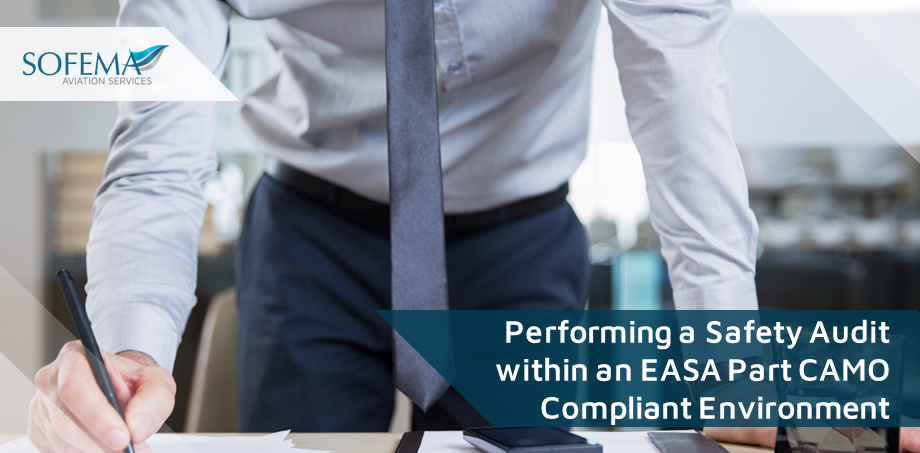Sofema Aviation Services (SAS) reviews the main characteristics of a Safety Audit within an EASA Part CAMO Compliant Environment
An Effective Safety Management System (SMS) can be considered as a game-changer where the organisation can :
- Identify what are the risks
- Establish how these risks are mitigated and
- Determine if the mitigations are effective
Presented by Steve Bentley – CEO of Sofema Aviation Services & SofemaOnline
- Considering the Role & Purpose of the “Safety Audit”
- Considering the Difference Between Quality & Safety Audits
The Basics
- Quality Audits are “Prescriptive” Assessments (Independent) of either external regulatory obligations or internal organisational system obligations.
- Safety Audits assess a system or process to identify hazards and determine the risk of such “Hazards” impacting the business in an “Unacceptable” way.
- Safety Audits are Subjective because they are essentially opinions based on the understanding of the assessing “subject matter expert”.
So How to Perform a Safety Audit?
Now that we know that we are looking at the risk associated with “organisational hazards”
Please visit our Library
Now – choose a Hazard – As part of determining the Risk – you decide to perform a Safety Audit
Here are the Core Safety Audit Questions
Step 1 – Turn the Story Around
This situation is not a threat to our organisation because:
- The Procedure is Strong & Robust
- The Management of the Process is Effective and Well Controlled
- The Communication related to the Process is Strong and documented – Including all stakeholders internal /external
- The Training associated with the situation is effective and verifiable
- We have no findings/observations during QA Audits
- There are no voluntary reports which concern any of these aspects
- We have sufficient Manpower to provide effective delivery of process
Step 2 – Looking into the Future
This situation is not a threat to our organisation because:
- The Process management is effective now and seen to be scaleable into the future – what happens with new starters?
- The Communication Process is effective through & across the business
- New Starters who involve in the process receive training as required – how decided & how measured for effectiveness
Note that in each case you are making “judgment calls”.
What Does EASA expect to take place in a Safety Review Board Meeting?
Both the Accountable Manager & Nominated Persons should participate in the SRB.
The SRB should provide a risk picture of the organisation. Up to a certain type/level of risk, the safety/operational managers should take actions without a decision of the SRB.
The Safety Review Board (SRB) provides the opportunity to gain a picture of risk awareness and see the effectiveness of the system at work.
- Major hazards which have been identified are discussed and safety risks are prioritised
- Any required mitigation measures are agreed (Accountable Manager arbitrates and takes final decisions)
- The implementation of actions and effectiveness of taken measures are monitored
(Note the combination of QA & SA – QA looks at the compliance with documented procedures & SA measures the effectiveness of implemented mitigations) - Safety performance is assessed against the safety policy and objectives
- To ensure that appropriate resources are allocated
- To also review Compliance Audit findings and to have oversight of corrective and preventive actions
What will EASA – NAA Inspectors expect to see during an Audit?
- Advance circulation of SRB papers and agenda – Means evidence of SMS Communications throughout the Organisation.
- Meeting Effectiveness – How long do they last and what output is generated – Note that regarding frequency and length of SRB meetings – It is Quality over Quantity (A 2-hour effective meeting is of more value than a 4-hour ineffective meeting)
- Who has participated in the meeting plus their accountability and authority?
- Standing agenda items (e.g. output from each of the monitoring processes) – How effective are these meetings and how is the value taken into account during performance monitoring?
- Minutes and actions, and their distributions
- Follow-up of previous actions
- EASA recommends Competent Authority Participation at Safety Review Board Meetings (If possible) – (This will be a measure of the effectiveness of NAA oversight)
Additional Notes Concerning Regulatory Authority
The CA should Inform the CAMO about the willingness to participate in SRB as an observer by clearly defining the attendance’s objectives and protocol. Access to safety-critical information during such meeting should not be used to raise findings against the organisation.
General Notes & Observations
- Green for everything will be seen as a red flag – an inappropriate (or not honest) risk analysis!
- For the risk to be closed down – shown as mitigated requires implementation & follow-up.
An Effective Safety Management System (SMS) can be considered as a game-changer where the organisation is able to
- Identify what are the risks
- Establish how these risks are mitigated and
- Determine if the mitigations are effective
What`s more :
Next Steps
Follow this link to our Library to find & download related documents for Free.
Please see Sofema Aviation Services & SofemaOnline for details of all available EASA Part CAMO related training courses – please email team@sassofia.com
Tags:
aviation, aviation safety, EASA, Quality Audit, Safety Management System, Training courses, EASA Part – CAMO, Regulatory Authority, Safety Audit, Safety Review Board




